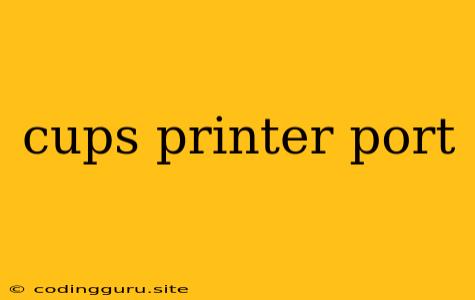Understanding CUPS Printer Ports: A Comprehensive Guide
Printing is a common task in our digital lives. Whether you're a student working on assignments, a business owner creating reports, or simply someone who enjoys printing photos, a smooth printing experience is essential. But have you ever wondered what's happening behind the scenes when you send a print job? A critical component in this process is the CUPS printer port, a vital connection between your computer and your printer.
What is CUPS?
CUPS, short for Common Unix Printing System, is a powerful software suite that manages printing tasks on Unix-like operating systems, including macOS and Linux. It acts as a central hub, receiving print jobs from your computer and directing them to the appropriate printer.
Why are Printer Ports Important?
Think of a printer port as the address your computer uses to find your printer. It's a unique identifier that tells your system exactly where to send the print job. Without a properly configured printer port, your computer won't be able to locate your printer and you'll encounter errors.
Types of Printer Ports
There are several types of printer ports, each with its own characteristics and applications:
- USB: The most common and user-friendly connection type, USB ports are known for their ease of use and versatility.
- Parallel: While less prevalent now, parallel ports were once the standard for connecting printers. They offer high-speed data transfer but are not as adaptable as USB.
- Network: This type of port allows printers to be shared across a network, giving multiple users access.
- Serial: Similar to parallel ports, serial ports offer slower data transfer rates but can be useful for specific applications.
- IP: This port utilizes the internet protocol to connect your printer to your network, providing convenient access from any device on the network.
Common CUPS Printer Port Errors
Occasionally, you might encounter errors related to CUPS printer ports. Here are some common issues and potential solutions:
- Port Already in Use: This error means another application is using the designated port. You can try restarting your computer or closing any programs that might be using the port.
- Port Not Available: This error indicates a problem with the printer connection. Check the physical connection and ensure the printer is powered on.
- Invalid Port: This error could occur if the port number is incorrect or invalid. You'll need to verify the port configuration and make any necessary adjustments.
Troubleshooting CUPS Printer Ports
If you're experiencing problems with CUPS printer ports, here are some troubleshooting tips:
- Check the Printer Connection: Ensure that the printer is properly connected to your computer, whether via USB, network, or other methods.
- Verify the Port Configuration: Access the CUPS web interface (usually found at http://localhost:631) and verify that the port number is correct and matches the printer's configuration.
- Restart the Printing System: Sometimes restarting the printing system can resolve connection issues. You can do this by restarting your computer and/or restarting the CUPS service.
- Reinstall the Printer Driver: An outdated or corrupt printer driver can cause problems. Reinstalling the driver from the manufacturer's website can often fix the issue.
Using CUPS Printer Ports
To print successfully, your computer needs to find the correct CUPS printer port. Here's how to use CUPS printer ports effectively:
- Add a New Printer: In your operating system's printer settings, choose "Add Printer" or "Add Device."
- Select the Printer: Choose the printer you want to add from the list of available devices.
- Choose a Port: Select the correct CUPS printer port that corresponds to your printer's connection type.
- Install the Driver: If necessary, install the printer driver for your specific model.
Conclusion
Understanding CUPS printer ports is essential for a seamless printing experience. By correctly configuring and troubleshooting printer ports, you can ensure your computer and printer communicate efficiently and print documents without any issues.
